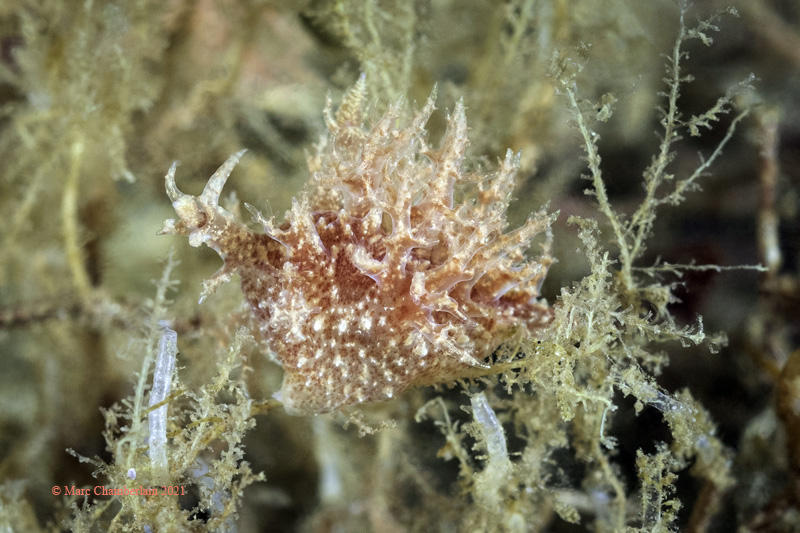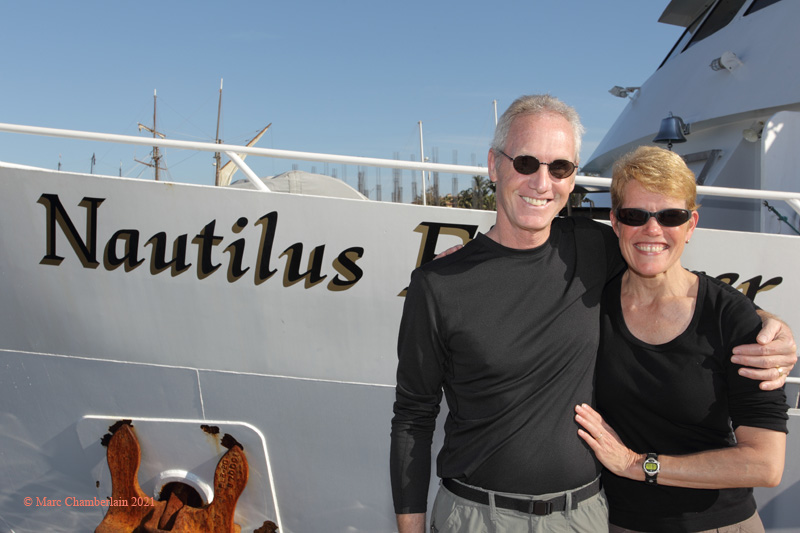 |
Image courtesy of Marc Chamberlain
Alki Junkyard Puget Sound Salish Sea West Seattle Washington
Image courtesy of Marc Chamberlain |
Dendronotus venutus MacFarland 1966 This is one of the most variable species on the Pacific Coast of North America, making it terribly difficult to identify. For years we referred to it as Dendronotus frondosus, an Atlantic species. It has only been recently that we determined that MacFarland's critter was genetically distinct from D. frondosus. Marc's photo really shows the elaborate dorsal appendages, which hide most of the external anatomy. We do have a nice view of the rhinophoral crown and clavus. Nice to see what the eggs look like, also. FYI - the inset photo of this species (#200) on page 94 of my Eastern Pacific Nudibranchs book, is incorrect, and in fact is a shot of Dendronotus subbramosus. Thanks Dr. C. Dave Behrens Sammamish, WA 98074 Jun., 2021 Send Dave email at davidwbehrens@gmail.com |
Marc,and Michelle Chamberlain
 |
Marc and Michelle Chamberlain reside in the Pacific Northwest in Seattle, Washington where they have lived for the last 15 years. They enjoy cold water diving and take advantage of their location to dive Puget Sound, Hood Canal, the San Juan Islands and the Olympic Peninsula all in Washington as well as multiple locations in British Columbia and southeast Alaska whenever possible. They also travel abroad (pre-pandemic), often combining land and water opportunities as in a trip to New Zealand, where they did extensive bird watching and hiking in addition to diving the Poor Knight's Islands (which I am going to put on my places to visit list).
Marc has a Nikon D500 in a Subal housing with 2 YS-D2 strobes and diffusers in addition to a variety of lenses. Marc in his time in San Diego was club Photographer of the Year so many times that I lost count! In fact Marc came to mind many summers ago during a trip on the Catalina Express from Dana Point. Due to a loading snafu, the bag containing my camcorders was stowed down below and therefore unavailable during the hop over to Catalina. Well, you guessed it!, a Blue breeched about 50 feet off the boat and hung around for about 10 minutes for everyone onboard to get a shot. That is with the exception of yours truly! During the remainder of the voyage the only thought that came to mind was "if Marc has been onboard he would have been ready." That be the difference folks between those who dream and those who actually do it!
Send Marc email at marccchamberlain@gmail.com |

Attention all you Sluggers, and you know who you are! The NSSI 2nd edition is now available in ebook PDF and book form . The hard back version will become available Nov. 1st. Both will cost $65 (individually). You will need to jump through a few hoops to get the electronic version as pdf distribution is protected by Adobe ID!! Please read the following to enable reading your electronic purchase! This new 2nd Edition is updated and reorganized, including 185 new species. Among other features, the new edition includes additional photographs of species, an identification key, and an up-to-date classification reflecting the latest evolutionary relationships. The Indo-Pacific represents the largest expanse of tropical ocean in the world, stretching from the Indian Ocean coast of southern Africa and the Red Sea to the central Pacific of the Hawaiian Islands, Easter Island and the Marquesas. This region supports the most diverse marine fauna of any place in the world for most groups of marine organisms. The nudibranchs and sea slugs are no exception to this rule; there are about 3,000 described species of these organisms in the world and at least 40% of these have been found exclusively in the Indo-Pacific tropics. This book illustrates 2,138 Indo-Pacific nudibranchs and sea slugs, including many undescribed species.
|

|
